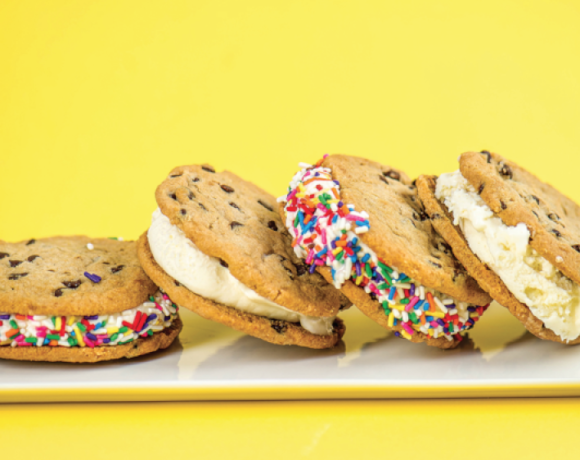Crunchy, savory pizza is a comfort food that is beloved across the globe. Everyone should have a go-to pizza recipe in his or her culinary repertoire.
This recipe for “Crispy Cheesy Pan Pizza,” has crispy golden edges with a thick layer of melted cheese to go with a delicate crust. With minimal kneading, the dough doesn’t require fancy equipment — just the typical home kitchen.
Crispy Cheesy Pan Pizza
Yield One 9- to 10-inch pan pizza
Crust
2 cups King Arthur Unbleached All-Purpose Flour
3⁄4 teaspoon salt
1⁄2 teaspoon instant yeast or active dry yeast
3⁄4 cup lukewarm water
1 tablespoon olive oil plus 11⁄2 tablespoons for the pan
Topping
6 ounces mozzarella, grated (about 11⁄4 cups, loosely packed)
1⁄3 to 1⁄2 cup tomato sauce or pizza sauce, homemade or store-bought
Freshly grated hard cheese (e.g. Parmesan, Asiago, Romano) and fresh herbs (oregano, basil, thyme) for sprinkling on top after baking, (optional)
1. Weigh your flour; or measure it by gently spooning it into a cup, then sweeping off any excess.
2. Place the flour, salt, yeast, water, and 1 tablespoon of the olive oil in the bowl of a stand mixer or other medium-large mixing bowl.
3. Stir everything together to make a shaggy, sticky mass of dough with no dry patches of flour. This should take 30 to 45 seconds in a mixer using the beater paddle; or about 1 minute by hand, using a spoon or spatula. Scrape down the sides of the bowl to gather the dough into a rough ball; cover the bowl.
4. After 5 minutes, uncover the bowl and reach a bowl scraper or your wet hand down between the side of the bowl and the dough, as though you were going to lift the dough out. Instead of lifting, stretch the bottom of the dough up and over its top. Repeat three more times, turning the bowl 90 degrees each time. This process of four stretches, which takes the place of kneading, is called a fold.
5. Re-cover the bowl, and after 5 minutes do another fold. Wait 5 minutes and repeat; then another 5 minutes, and do a fourth and final fold. Cover the bowl and let the dough rest, undisturbed, for 40 minutes. Then refrigerate it for a minimum of 12 hours, or up to 72 hours. It will rise slowly as it chills, developing flavor; this long rise will also add flexibility to your schedule.
6. About 3 hours before you want to serve your pizza, prepare your pan. Pour 11⁄2 tablespoons olive oil into a well-seasoned cast iron skillet that’s 10 inches to 11 inches in diameter across the top, and about 9 inches across the bottom. Heavy, dark cast iron will give you a superb crust; but if you don’t have it, use another oven-safe heavy-bottomed skillet of similar size, or a 10-inch round cake pan or 9-inch square pan. Tilt the pan to spread the oil across the bottom, and use your fingers or a paper towel to spread some oil up the edges, as well.
7. Transfer the dough to the pan and turn it once to coat both side with the oil. After coating the dough in oil, press the dough to the edges of the pan, dimpling it using the tips of your fingers in the process. The dough may start to resist and shrink back; that’s okay, just cover it and let it rest for about 15 minutes, then repeat the dimpling/pressing. At this point the dough should reach the edges of the pan; if it doesn’t, give it one more 15-minute rest before dimpling/pressing a third and final time.
8. Cover the crust and let it rise for 2 hours at room temperature. The fully risen dough will look soft and pillowy and will jiggle when you gently shake the pan.
9. About 30 minutes before baking, place one rack at the bottom of the
oven and one toward the top. Preheat the oven to 450 F.
10. When you’re ready to bake the pizza, sprinkle about three-quarters of the mozzarella (a scant 1 cup) evenly over the crust. Cover the entire crust, no bare dough showing; this will yield caramelized edges. Dollop small spoonfuls of the sauce over the cheese; laying the cheese down first like this will prevent the sauce from seeping into the crust and making it soggy. Sprinkle on the remaining mozzarella.
11. Bake the pizza on the bottom rack of the oven for 18 to 20 minutes, until the cheese is bubbling and the bottom and edges of the crust are a rich golden brown (use a spatula to check the bottom). If the bottom is brown but the top still seems pale, transfer the pizza to the top rack and bake for 2 to 4 minutes longer. On the other hand, if the top seems fine but the bottom’s not browned to your liking, leave the pizza on the bottom rack for another 2 to 4 minutes. Home ovens can vary a lot, so use the visual cues and your own preferences to gauge when you’ve achieved the perfect bake.
12. Remove the pizza from the oven and place the pan on a heatproof surface. Carefully run a table knife or spatula between the edge of the pizza and side of the pan to prevent the cheese from sticking as it cools. Let the pizza cool very briefly; as soon as you feel comfortable doing so, carefully transfer it from the pan to a cooling rack or cutting surface. This will prevent the crust from becoming soggy.
13. Serve the pizza anywhere from medium-hot to warm. Kitchen shears or a large pair of household scissors are both good tools for cutting this thick pizza into wedges.








Recent Comments